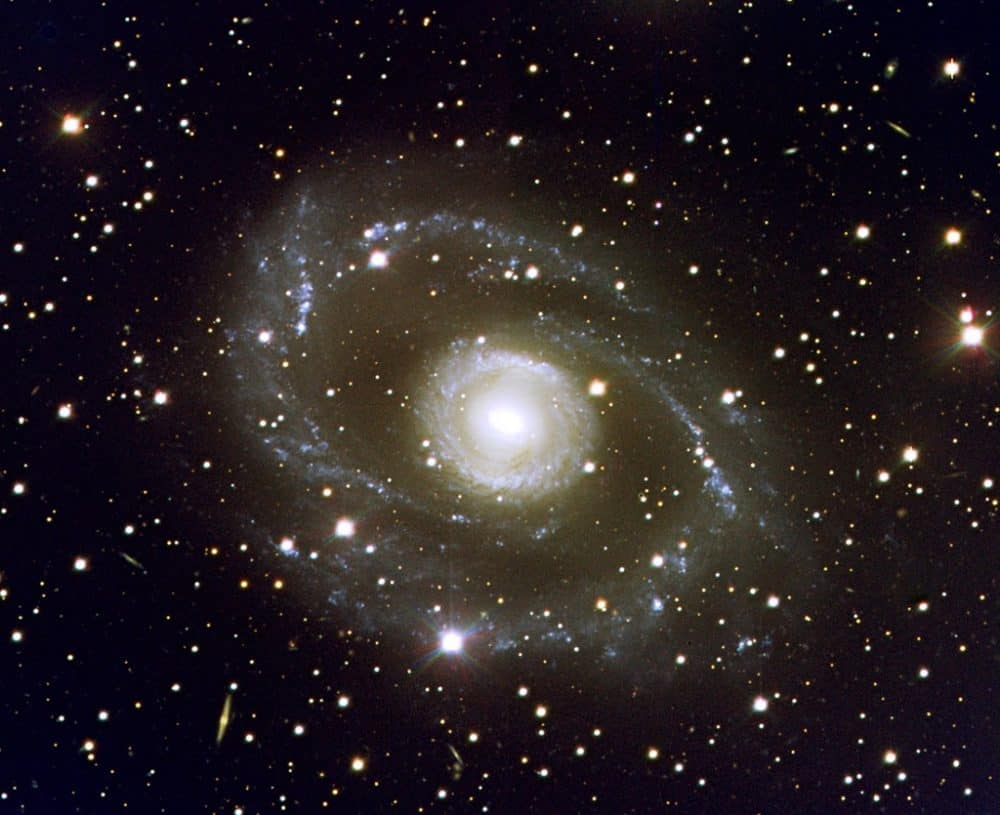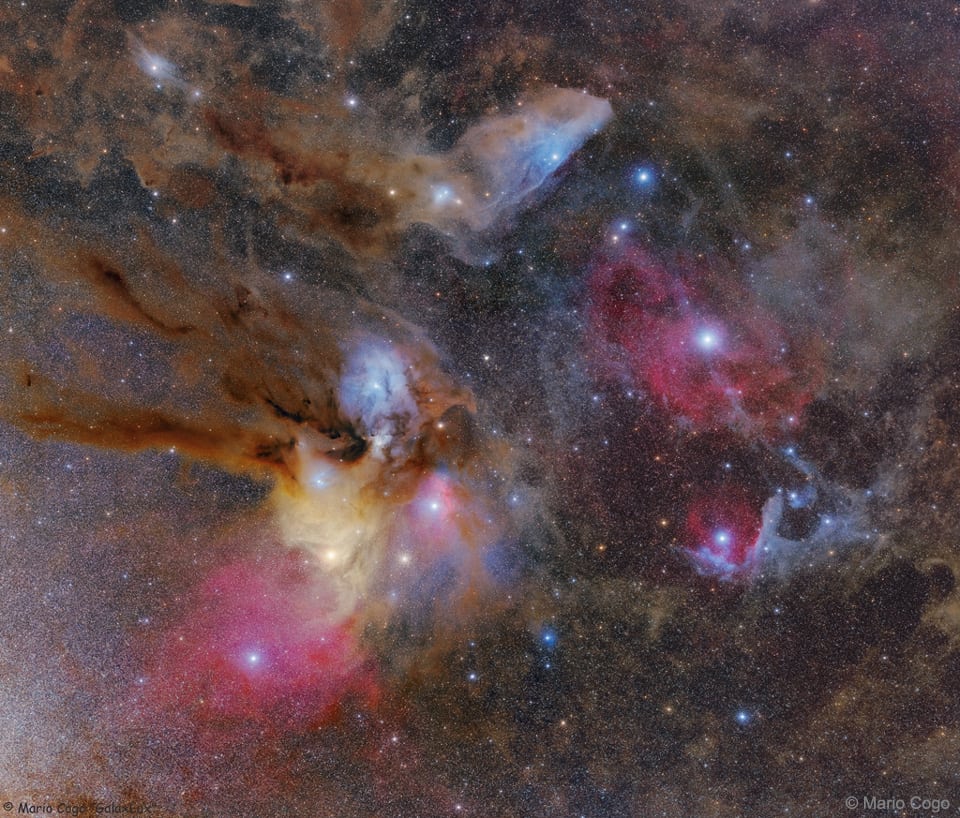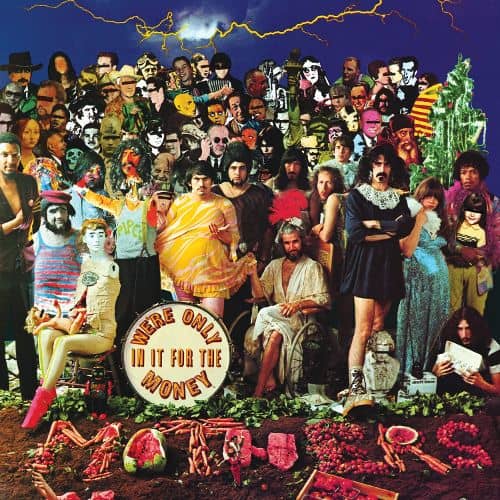Blog
ESO 269-G57 is a huge barred spiral galaxy of nearly 200,000 light-years across (almost twice as large as our Milky Way galaxy!), located some 155 million light-years away towards the southern constellation of Centaurus (the Centaur), in the center of the Centaurus cluster of galaxies. It is speeding away from us at roughly 3110 kilometers per second.
This galaxy was discovered during the ESO/Uppsala Survey of the Southern Skies in the 1970s, during which over 15,000 southern galaxies were found.
This symmetrical starburst galaxy shows us its central galactic nucleus (yellow), surrounded by an inner ring of tightly wound spiral arms. Spiralling out from this are two more diffuse spiral arms that appear to split into several branches. The spiral arms and the inner ring contain many star-forming regions (blue). ESO 269-G57 consists of about 300 billion stars and 270 billion multiple star systems.
In 1992 supernova 1992K was observed in this galaxy, south-west of its nucleus.
The data for this image were obtained with the Very Large Telescope using several filters on the ANTU and FORS1 instruments on 27 March 1999, and further processed by Henri Boffin (ESO). The image includes many foreground stars and distant background galaxies. North is up and East is to the left.
more...John Symon Asher Bruce (14 May 1943 – 25 October 2014) was a Scottish musician, singer and songwriter known primarily for his contributions to the British supergroup Cream, which also included the guitarist-singer Eric Clapton and the drummer Ginger Baker. In March 2011 Rolling Stone readers selected him as the eighth greatest bass guitarist of all time. “Most musicians would have a very hard time distinguishing themselves if they wound up in a band with Eric Clapton and Ginger Baker,” the magazine said at the time, “but Jack Bruce was so gifted on the bass that he did it with ease.”
Bruce maintained a solo career that spanned several decades and also played in several musical groups. Although recognized first and foremost as a vocalist, bassist and songwriter, he also played double bass, harmonica, piano, cello and guitar. He was trained as a classical cellist and considered himself a jazz musician, although much of his catalogue of compositions and recordings tended toward rock and blues.
more...Sidney Bechet (May 14, 1897 – May 14, 1959) was an American jazz saxophonist, clarinetist, and composer. He was one of the first important soloists in jazz, beating trumpeter Louis Armstrong to the recording studio by several months. His erratic temperament hampered his career, and not until the late 1940s did he earn wide acclaim.
Bechet was born in New Orleans in 1897 to a middle-class Creole of color family. His older brother, Leonard Victor Bechet, was a full-time dentist and a part-time trombonist and bandleader. Bechet learned several musical instruments that were kept around the house, mostly by teaching himself; he decided to specialize in the clarinet. At the age of six, he started playing with his brother’s band at a family birthday party, debuting his talents to acclaim. Later in his youth, Bechet studied with Lorenzo Tio, “Big Eye” Louis Nelson Delisle, and George Baquet.
Bechet played in many New Orleans ensembles using the improvisational techniques of the time (obbligatos with scales and arpeggios and varying the melody). He performed in parades with Freddie Keppard‘s brass band, the Olympia Orchestra, and in John Robichaux‘s dance orchestra. From 1911 to 1912, he performed with Bunk Johnson in the Eagle Band of New Orleans and in 1913–14 with King Oliver in the Olympia Band. From 1914 to 1917 he was touring and traveling, going as far north as Chicago and frequently performing with Freddie Keppard. In the spring of 1919, he traveled to New York City where he joined Will Marion Cook‘s Syncopated Orchestra. Soon after, the orchestra traveled to Europe; almost immediately upon arrival, they performed at the Royal Philharmonic Hall in London. The group was warmly received, and Bechet was especially popular. While in London, he discovered the straight soprano saxophone and developed a style unlike his clarinet tone. His saxophone sound could be described as emotional, reckless, and large. He often used a broad vibrato, similar to what was common among some New Orleans clarinetists at the time. On July 30, 1923, he began recording. The session was led by Clarence Williams, a pianist and songwriter, better known at that time for his music publishing and record producing. Bechet recorded “Wild Cat Blues” and “Kansas City Man Blues”. “Wild Cat Blues” is in a ragtime style with four 16-bar themes, and “Kansas City Man Blues” is a 12-bar blues.
more...https://www.youtube.com/watch?v=34OwiSJXBTI
more...Judge Judy & the incomparable prankster himself the mickster, airing tomorrow Tuesday May 14th 2019 coast to coast. Hold on to your Jurisprudence kids its way over the top and more! I’m shocked they are airing this one probably with edits???
S23 E199 season 23 episode 199
“Where There’s Smoke … There’s More Smoke!” NEW!
In Minneapolis its the 430pm slot, there is also a 4pm show. So apparently Judge Judy is aired twice daily on nationwide networks. Look for S23 E199 and bingo thats it! It is listed on the internet. LETS GO VIRAL! Record and post to youtube! LOL
The colorful clouds surrounding the star system Rho Ophiuchi compose one of the closest star forming regions. Rho Ophiuchi itself is a binary star system visible in the blue reflection nebula just to the left of the image center. The star system, located only 400 light years away, is distinguished by its multi-colored surroundings, which include a red emission nebula and numerous light and dark brown dust lanes. Near the lower left of the Rho Ophiuchi molecular cloud system is the yellow star Antares, while a distant but coincidently-superposed globular cluster of stars, M4, is visible just to the right of Antares. Near the image top lies IC 4592, the Blue Horsehead nebula. The blue glow that surrounds the Blue Horsehead’s eye — and other stars around the image — is a reflection nebula composed of fine dust. On the featured image right is a geometrically angled reflection nebula cataloged as Sharpless 1. Here, the bright star near the dust vortex creates the light of surrounding reflection nebula. Although most of these features are visible through a small telescope pointed toward the constellations of Ophiuchus, Scorpius, and Sagittarius, the only way to see the intricate details of the dust swirls, as featured above, is to use a long exposure camera.
more...Stevland Hardaway Morris (né Judkins; born May 13, 1950), better known by his stage name Stevie Wonder, is an American singer, songwriter, musician, record producer, and multi-instrumentalist.
A child prodigy, Wonder is considered to be one of the most critically and commercially successful musical performers of the late 20th century. He signed with Motown‘s Tamla label at the age of 11, and continued performing and recording for Motown into the 2010s. He has been blind since shortly after his birth. Among Wonder’s works are singles such as “Signed, Sealed, Delivered I’m Yours“, “Superstition“, “Sir Duke“, “You Are the Sunshine of My Life“, and “I Just Called to Say I Love You“; and albums such as Talking Book (1972), Innervisions(1973), and Songs in the Key of Life (1976). He has recorded more than 30 U.S. top-ten hits and received 25 Grammy Awards, one of the most-awarded male solo artists, and has sold more than 100 million records worldwide, making him one of the top 60 best-selling music artists.
Wonder is also noted for his work as an activist for political causes, including his 1980 campaign to make Martin Luther King Jr.‘s birthday a holiday in the United States. In 2009, Wonder was named a United Nations Messenger of Peace. In 2013, Billboard magazine released a list of the Billboard Hot 100 All-Time Top Artists to celebrate the US singles chart’s 55th anniversary, with Wonder at number six.
more...William McKinley “Red” Garland, Jr. (May 13, 1923 – April 23, 1984) was an American modern jazz pianist. Known for his work as a bandleader and during the 1950s with Miles Davis, Garland helped popularize the block chord style of piano playing. William “Red” Garland was born in 1923 in Dallas, Texas. He began his musical studies on the clarinet and alto saxophone but, in 1941, switched to the piano. Less than five years later, Garland joined the trumpet player Hot Lips Page, well-known in the southwest, playing with him until a tour ended in New York in March 1946. Having decided to stay in New York to find work, Art Blakey came across Garland playing at a small club, only to return the next night with Blakey’s boss, Billy Eckstine.
Garland also had a short-lived career as a welterweight boxer in the 1940s. He fought more than 35 fights, one being an exhibition bout with Sugar Ray Robinson. Garland became famous in 1954 when he joined the Miles Davis Quintet, featuring John Coltrane, Philly Joe Jones, and Paul Chambers. Davis was a fan of boxing and was impressed that Garland had boxed earlier in his life. Together, the group recorded their famous Prestige albums, Miles: The New Miles Davis Quintet (1954), Workin, Steamin’, Cookin’, and Relaxin’. Garland’s style is prominent in these seminal recordings—evident in his distinctive chord voicings, his sophisticated accompaniment, and his musical references to Ahmad Jamal’s style. Some observers dismissed Garland as a “cocktail” pianist, but Miles was pleased with his style, having urged Garland to absorb some of Jamal’s lightness of touch and harmonics within his own approach.
more...Ian Ernest Gilmore Evans (born Green; May 13, 1912 – March 20, 1988) was a Canadian jazz pianist, arranger, composer and bandleader. He is widely recognized as one of the greatest orchestrators in jazz, playing an important role in the development of cool jazz, modal jazz, free jazz, and jazz fusion. He is best known for his acclaimed collaborations with Miles Davis.
https://www.youtube.com/watch?v=xAVzB2ifVZo
more...The Heart Nebula, IC 1805, Sharpless 2-190, lies some 7500 light years away from Earth and is located in the Perseus Arm of the Galaxy in the constellation Cassiopeia. It was discovered by William Herschel on 3 November 1787. This is an emission nebula showing glowing ionized hydrogen gas and darker dust lanes.
The very brightest part of this nebula (the knot at the western edge) is separately classified as NGC 896, because it was the first part of this nebula to be discovered.
The nebula’s intense red output and its configuration are driven by the radiation emanating from a small group of stars near the nebula’s center. This open cluster of stars known as Melotte 15 contains a few bright stars nearly 50 times the mass of our Sun, and many more dim stars that are only a fraction of our Sun’s mass.
more...Stephen Lawrence Winwood (born 12 May 1948) is an English singer and musician whose genres include progressive rock, blue-eyed soul, rhythm and blues, blues rock, pop rock, and jazz. Though primarily a vocalist and keyboardist, Winwood also plays a wide variety of other instruments; on several of his solo albums he recorded all instrumentation including drums, guitars, and keyboards.
Winwood was a key member of The Spencer Davis Group, Traffic, Blind Faith and Go. He also had a successful solo career with hits including “While You See a Chance“, “Valerie“, “Back in the High Life Again” and two US Billboard Hot 100 number ones, “Higher Love” and “Roll with It“. He was inducted into the Rock and Roll Hall of Fame as a member of Traffic in 2004.
In 2005, Winwood was honoured as a BMI Icon at the annual BMI London Awards for his “enduring influence on generations of music makers”. In 2008, Rolling Stone ranked Winwood No. 33 in its 100 Greatest Singers of All Time. Winwood has won two Grammy Awards. He was nominated twice for a Brit Award for Best British Male Artist: 1988 and 1989. In 2011 he received the Ivor Novello Award from the British Academy of Songwriters, Composers and Authors for Outstanding Song Collection.
more...Gary Peacock (born May 12, 1935, in Burley, Idaho, United States) is an American jazz double-bassist.
Peacock spent time in Japan in the late 1960s, abandoning music temporarily and studying Zen philosophy. After returning to the United States in 1972, he studied Biology at the University of Washington in Seattle and taught music theory at Cornish College of the Arts from 1976 to 1983.
In 1983, he joined Keith Jarrett‘s “Standards Trio” with Jack DeJohnette (the three musicians had previously recorded Tales of Another in 1977 for ECM Records, under Peacock’s leadership). Among the trio’s albums are Standards, Vol. 1 and Standards, Vol. 2 and Standards Live.
more...NGC 2903 is located about 30 million light-years away in the constellation of Leo (The Lion), and was studied as part of a Hubble survey of the central regions of roughly 145 nearby disc galaxies. This study aimed to help astronomers better understand the relationship between the black holes that lurk at the cores of galaxies like these, and the rugby-ball-shaped bulge of stars, gas, and dust at the galaxy’s centre — such as that seen in this image.
NGC 2903 is a field barred spiral galaxy about 30 million light-years away in the constellation Leo. It was discovered by William Herschel who cataloged it on November 16, 1784. NGC 2903 has a very high rate of star formation in its central region. NGC 2905 is a bright star cloud within this galaxy. NGC 2903 is part of the Virgo Supercluster.
more...More Posts
- World Music with Obo Addy
- Daily Roots with Bob Marley
- The Cosmos with Fleming 1
- Ernest Ranglin Day
- Billy Drummond Day
- World Music with Lela Tataraidze
- Daily Roots with the Skatalites
- The Cosmos with NGC 6872 & IC 4970
- Paul McCartney Day
- William Hooker Day
- Rudy Rutherford Day
- World Fusion with Manika Kaur
- Daily Roots with the Congos
- Happy Fathers Day 2018
- The Cosmos with RCW 108
- Chuck Rainey Day
- Sing Miller Day
- World Music with Corvus Corax
- Daily Roots with ITSJAHMIEL
- The Cosmos with NGC 3372







